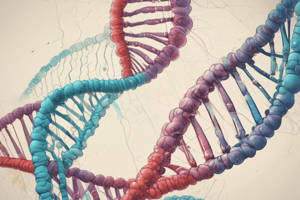Podcast
Questions and Answers
What is the name of the complex macromolecule composed of nucleotides in living organisms?
What is the name of the complex macromolecule composed of nucleotides in living organisms?
- Carbohydrate
- RNA
- DNA (correct)
- Protein
Which nitrogenous base always pairs with adenine in DNA?
Which nitrogenous base always pairs with adenine in DNA?
- Uracil
- Guanine
- Cytosine
- Thymine (correct)
What is the enzyme responsible for transcribing DNA into mRNA during gene expression?
What is the enzyme responsible for transcribing DNA into mRNA during gene expression?
- DNA polymerase
- Helicase
- Ligase
- RNA polymerase (correct)
Which process involves the synthesis of proteins based on the information encoded in mRNA?
Which process involves the synthesis of proteins based on the information encoded in mRNA?
During transcription, which DNA strand is used as a template to synthesize mRNA?
During transcription, which DNA strand is used as a template to synthesize mRNA?
What is the primary role of introns in the process of gene expression?
What is the primary role of introns in the process of gene expression?
Which of the following modifications helps protect the mRNA from degradation and ensures efficient translation?
Which of the following modifications helps protect the mRNA from degradation and ensures efficient translation?
What is the primary function of transfer RNAs (tRNAs) during translation?
What is the primary function of transfer RNAs (tRNAs) during translation?
Which of the following statements about protein folding is true?
Which of the following statements about protein folding is true?
What is the primary role of ribosomes in the translation process?
What is the primary role of ribosomes in the translation process?
Study Notes
Gene Code
The gene code is the sequence of genetic instructions stored within DNA molecules found in living organisms. These instructions dictate the development, function, and behavior of cells, tissues, organs, and entire organisms. Let's delve into two essential aspects of this fascinating subject: the structure of genes and their expression process.
DNA Structure
DNA, or Deoxyribonucleic Acid, is a complex macromolecule composed of nucleotides. Each nucleotide consists of three components: a sugar molecule called deoxyribose, a phosphate group, and one of four nitrogenous bases - adenine, cytosine, guanine, or thymine. In its double helix form, these building blocks arrange themselves in pairs, with adenine always pairing with thymine, and cytosine always pairing with guanine. This complementary base pairing ensures the fidelity of genetic information during replication and transcription processes.
Gene Expression
Gene expression refers to the process by which the information encoded in a gene is translated into functional proteins, ultimately leading to various cellular functions. It involves several stages such as transcription, post-transcriptional modification, translation, and protein folding.
Transcription
Transcription is the first step in gene expression, where the DNA sequence encoding a specific protein is transcribed into messenger RNA (mRNA). An enzyme called RNA polymerase reads the DNA sequence and synthesizes mRNA using the template strand of DNA. During this process, introns, noncoding sequences present within the gene, are removed from the nascent message, while exons, coding regions, remain intact.
Post-Transcriptional Modification
After transcription, the mRNA undergoes various post-transcriptional modifications, including addition of a cap and tail structures, splicing, and methylation. These modifications help protect the mRNA from degradation and ensure efficient translation.
Translation
Translation involves the conversion of the codon (a triplet of nucleotides) sequences in the mRNA to amino acid sequences in the final polypeptide chain through the decoding action of ribosomes. Transfer RNAs (tRNAs), carrying corresponding adaptor amino acids, recognize and interact with the mRNA via anticodon-codon interactions. The assembled polypeptide chain is finally released upon hydrolysis of the peptide bond between successive amino acids.
Protein Folding
Upon release from the ribosome, the newly formed polypeptide chains must fold into their native conformation to achieve proper function. Molecular chaperones assist in this process by stabilizing partially folded intermediates and preventing aggregation. Incorrect folding can lead to improper functioning of proteins or malfunctioning cells, affecting overall health.
Studying That Suits You
Use AI to generate personalized quizzes and flashcards to suit your learning preferences.
Description
Explore the fundamental concepts of gene code, focusing on the intricate structure of DNA molecules and the intricate process of gene expression. Learn about nucleotides, nitrogenous bases, transcription, translation, and protein folding.




